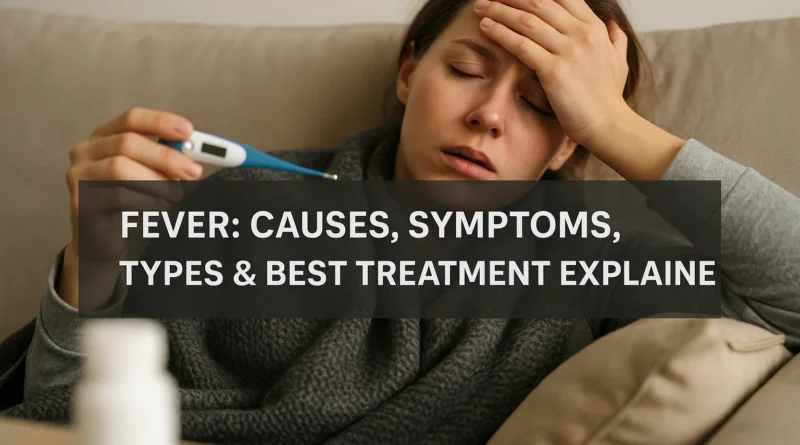What Causes Fever? Symptoms, Types & Best Treatment Explained
What is fever?
Fever, also known as pyrexia, is a temporary increase in body temperature caused by various underlying conditions or illnesses. Normal body temperature is usually around 37°C, but a temperature above 38°C indicates a fever. However, some sources note that a low-grade fever can start at a slightly lower temperature, about 37.5°C (99.5°F), especially in children or when certain medical conditions are present. If a fever lasts longer, it may be a sign of a bacterial or viral infection that requires prompt medical attention.
Why does body temperature rise when you have a fever?
A rise in body temperature is part of the immune defense mechanism. When bacteria or pathogens enter our body, a part of the brain called the hypothalamus triggers an increase in body temperature to slow down the growth of the pathogens and bacteria and boost WBC activity (white blood cells, which are part of the immune system) to better fight against infection.
What are the fever symptoms?
Fever is not a disease, but rather a symptom that may be related to various conditions. Symptoms that come with the fever include
- Headache & muscle pain
- Sweating
- Chills with shivering
- Tiredness (fatigue)
- Loss of appetite
- Dehydration
- Irritability (especially in children)
Note: If the above symptoms persist for more than 2-3 days, always seek medical advice before they worsen.
What are the Causes of Fever?
While there is not a single cause, it depends on different conditions. Here are some of the most common causes of fever:
- Infections: Infections such as viral infections (common cold, flu, and dengue), bacterial infections (such as strep throat, pneumonia, typhoid, or urinary tract infections), or parasitic infections (malaria, giardiasis) can trigger an immune response, causing fever.
- Inflammatory Conditions: Autoimmune diseases such as arthritis, lupus, or inflammatory bowel conditions can cause inflammatory conditions that can trigger fever-like conditions that require medical attention.
- Vaccinations: Vaccines, like the COVID vaccine or flu vaccines, are administered to infants and children, which can evoke an immune reaction leading to a mild fever.
- Medications: Certain medications, such as antibiotics, antihistamines, or seizure medicines, may cause fever as a side effect.
- Heat-related Conditions: Illnesses related to heat, such as heatstroke, can cause the core body temperature to rise, leading to fever.
- Treatment and Therapies: Certain cancer treatment therapies, such as chemotherapy, radiotherapy, or immunotherapy, can cause fever as a side effect.
- Blood-related cancer: Lymphoma and leukemia may lead to a weakened immune system, making the body susceptible to infections.
Note: For cancer-related conditions, accurate diagnosis and thorough testing are required to confirm the cause of fever.
What are the types of fever?
The table below summarizes the four main types of fever, categorized by their duration and temperature range.
| Type of Fever | Approx. Temperature Range | Typical Duration | Possible Causes | Medical attention |
| Low-Grade Fever | 99°F–100.4°F (37.2°C–38°C) | 1–3 days | Common cold, mild viral infections | Usually mild, monitor at home |
| Moderate Fever | 100.5°F–102°F (38.1°C–38.9°C) | 2–5 days | Seasonal flu, viral fever, and early dengue | May require medical advice |
| High Fever | 102°F–104°F (38.9°C–40°C) | Several days | Typhoid, pneumonia, bacterial infections | Advised Medical attention |
| Hyperpyrexia | Above 104°F (40°C) | Sudden or persistent | Heat stroke, sepsis, and brain hemorrhage | Medical emergency—find immediate care |
Note: Understanding the fever type and severity can help identify the underlying condition and guide proper diagnosis.
How to diagnose a fever?
- Diagnosis starts with a physical examination, in which your doctor may ask you about
- Symptoms and medical history, or they may perform a physical exam to check for any visible signs in your body.
- May take nasal or throat swabs to test for respiratory infections
- Depending on the severity, your doctor may recommend blood tests or imaging scans such as an MRI or CT scan to confirm the diagnosis.
Tests for fever:
Your doctor may recommend a blood test or imaging test, depending on your medical condition and diagnostic needs.
Blood tests
- Complete blood count (CBC) test: Examines blood for infections, anemia, or inflammation
- Blood culture: To check for any kind of bacterial infection
Other tests
- WIDAL test: to confirm the diagnosis of typhoid (occurs due to Salmonella)
- Dengue NS1 antigen or IgM/IgG test: To confirm malaria or dengue.
- Throat or Nasal Swab: To test for respiratory viruses like COVID-19, influenza, or strep throat.
- Tuberculosis (TB) Test: To check for tuberculosis, a Mantoux test or chest X-ray may be ordered.
Urine tests
- Urinalysis: to check for urinary tract infections or kidney issues.
- Urine culture: to check for bacterial growth in the urine.
Imaging test
- Chest X-ray: In case of lung infection
- Abdominal ultrasound: To check for any outgrowths, abscesses, or fluid buildup causing stomach pain
- MRI/CT scan: For deeper analysis of unexplained conditions or inflammatory conditions.
Management and Treatment
Fever is not the illness itself, but rather a sign of an underlying condition. Treating the underlying cause, reducing the temperature, and easing discomfort are the main goals of effective management.
You can manage fever at home by just following these basic steps:
- Drink plenty of water and keep yourself hydrated.
- Allow your body to recover and give yourself some rest.
- Apply a cold compress with the help of a wet cloth to the forehead and armpit to help reduce heat.
- If your child has a fever, dress them in light, comfortable clothing and use fans or air conditioners if necessary.
- Regularly monitor the temperature using an underarm thermometer (adults) or a rectal thermometer. (children)
How to treat a fever at home?
Fever treatment depends on the underlying cause; you can go for certain medications to reduce your fever, or you may consult a doctor if the fever persists for a long time.
Medications to lower the fever
- Acetaminophen, also known as paracetamol, is a safe and effective way for most people to reduce fever and discomfort.
- Ibuprofen aids in lowering inflammation and fever. Not advised for people with kidney problems or ulcers.
- Babies younger than 2 months may require hospitalization or intravenous medications in case of severe infection.
When to seek medical attention?
Fever is not usually a concern, but under some circumstances, you may need to seek medical advice for your baby, child, or yourself.
For Infants and Children
- Is younger than 3 months with any fever
- has a temperature above 40°C (104°F).
- Have a seizure, difficulty breathing, or are extremely sleepy.
- Has a rash, stiff neck, or shows signs of pain when moving.
- Has a fever lasting more than 3 days and a refusal to consume food or beverages.
- Or showing signs of dehydration (dry lips, no tears, sunken eyes).
For Adults
A fever above 39.4°C (103°F) is serious, along with common early signs such as
- Persistent headache
- unusual skin rash
- Increased sensitivity to light (photophobia)
- Stiffness in the neck or discomfort
- Confusion or unusual changes in speech or behavior
- Continuous vomiting
- Shortness of breath or chest discomfort
- Severe abdominal pain
- Burning Urination
- Seizures or convulsions
Note: Always share your medical history with your doctor or inform them if you are taking any other medications
What to ask my doctor?
- What is the possible cause of my fever?
- What tests will be required to identify the underlying problem?
- What treatment plan would you recommend for my condition?
- Is it necessary to take medication to lower the fever?
- Are there any precautions or activity restrictions I should follow during recovery?
How to prevent a fever?
You may lower your risk of getting a fever by following these basic tips:
- Get vaccinated for infectious diseases such as the flu and COVID-19.
- Maintain personal hygiene by washing your hands before or after eating, while using toilets, or if traveling somewhere.
- Avoid touching your eyes, nose, and mouth, as these are the main entrances through which bacteria and viruses may enter.
- Cover your mouth when you cough or sneeze.
- Avoid contact with an infected person, or if you are infected, use a mask to avoid spreading the infection.
Key Takeaway:
Fever is an indication that your body is battling an underlying problem, usually an infection, rather than a disease. Knowing its causes, symptoms, types, and the right course of treatment can help you respond effectively and seek timely medical care when needed. Always assess the severity and accompanying symptoms to determine whether home care is sufficient or professional assistance is required.
People may ask
What is considered a high fever?
A temperature above 102°F (38.9°C) is generally considered high, especially in adults.
What is a low-grade fever?
A low-grade fever (37.5°C–38°C) is usually harmless, but if it lasts or comes with other symptoms, it may need a doctor’s check.
What is recurrent fever?
Fevers that come and go multiple times affect children below the age of 5 and may last for a few days.
Does fever cause allergy?
Fever doesn’t cause allergies; however, some people may experience a very low-grade, mild fever as a result of an allergic reaction, especially if the reaction is systemic or involves inflammation.
How long should a fever last?
Depending upon the fever type and type of infection, it should pass within 3 to 4 days if managed and treated in time.




